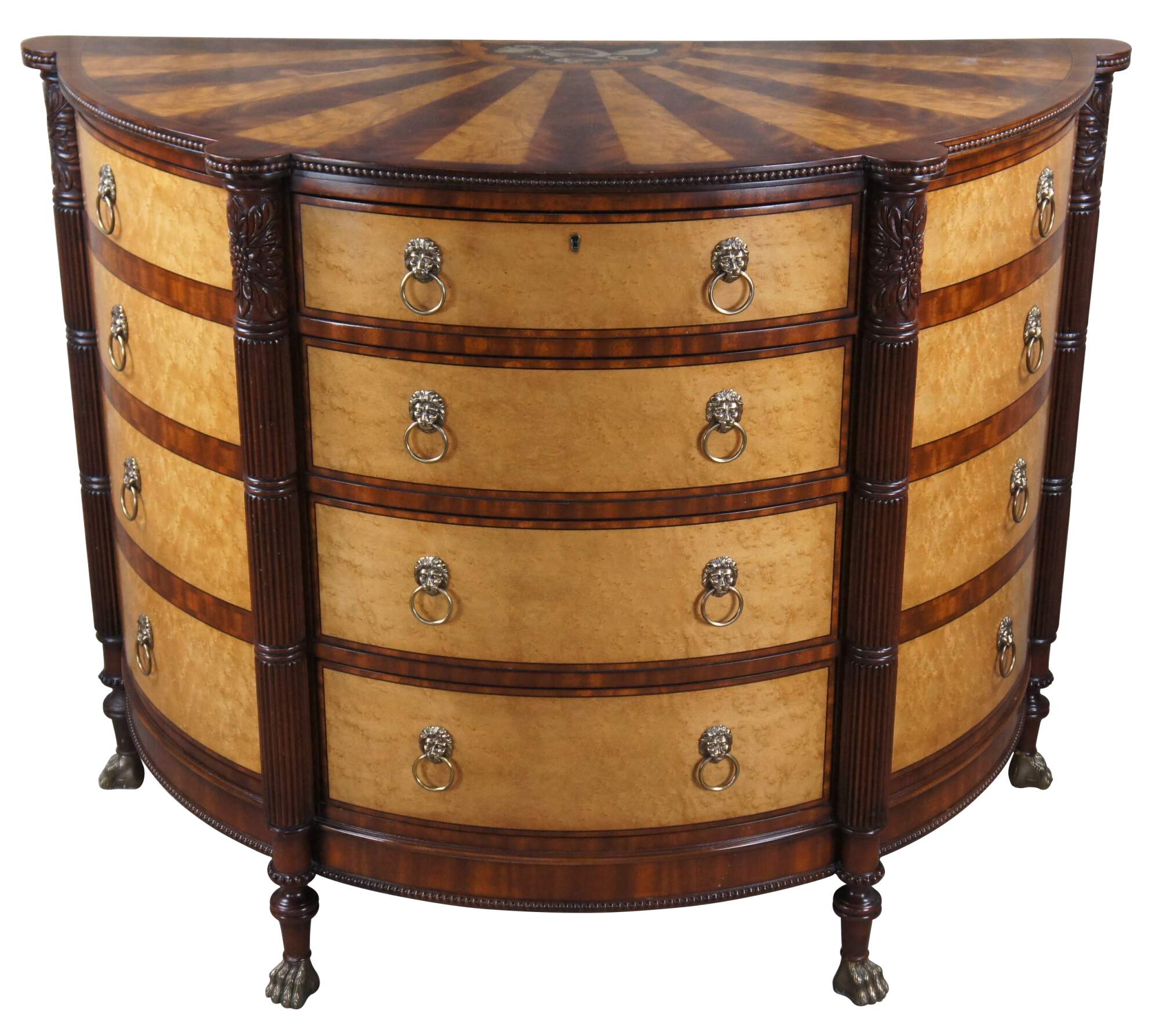
Shipping:
Free Shipping Included
Delivery:
Estimated 2-15 Business Days
Payments:
Credit Card, Check, Cash, PayPal, Apple Pay, Venmo
Returns:
30 Days 100% Money Back Guarantee, Buyer Pays Return Shipping
Description
A rare and impressive commode by Harold Ionson. Made of birdseye maple, satinwood and Honduras mahogany, featuring a half round / bow front with four drawers, two side cabinets, brass paw / claw feet and supurb sunburst / starburst top with nautical sea shell and cartusche theme. Includes silverwear insert by EJ Victor.
A total of nine of these Reproductions from the original were made over the course of a decade by Ionson and team. And although nearly 200 years separate the pieces, Thomas Seymour’s (1771–1848) demilune commode in the Museum of Fine Arts, Boston, and its modern-day re-creation by Harold Ionson can each deservedly be deemed masterworks of the highest order. Over the past twelve years, Ionson—perhaps the last of the Colonial Revival craftsmen who trained in the 1930s—has made nine re-creations of the original Federal commode made by Seymour in 1809.
“I always loved the piece,” says Ionson, “but the museum wasn’t selling.” His admiration led to hours of thorough study of the museum’s commode. He observed every nuance of its design, then made sketches and even casts of details before embarking on his own version.
“The most difficult part was finding the right figures for the veneers,” says Ionson, “but I found superb quilted bird’s-eye maple, satinwood, and Honduras mahogany.”
Ionson achieved such a sublime work of craftsmanship because he had few constraints. Unlike Seymour, Ionson possessed the luxury of time, modern machinery, and a greater selection of available woods (except ash). The work of both men, however, is distinguished by ingenuity and skill. Part of the challenge of the re-creation was to figure out just how Seymour made the piece, maintain its artistic integrity, and keep to the original’s exact measurements. The execution of the commodes took barely 10 percent of Ionson’s time; mostly he planned, designed, and invented needed tools for precise fabrication, such as a hand-built jig.
The top of the re-created commode features a sunburst of alternating mahogany and satinwood veneers emanating from a lunette of shells painted in oil by Jonathan L. Fairbanks, curator emeritus, Museum of Fine Arts, Boston; Fairbanks replicated the original by John Ritto Penniman (1782–1841). Courtesy of Harold Ionson.
Ionson thought of everything—from humidity’s effects on structural stresses to drawers popping open—when he considered innovations to the commode’s construction. His additions to the original design include hickory spring latches for the drawers, an apron carved from a solid piece of wood, and entirely veneered drawer-front edges. As his friends say, Ionson is “a perfectionist’s perfectionist.”
The original commode was commissioned by Elizabeth Derby West (1762–1814), the daughter of Elias Hasket Derby, a prominent Salem merchant and America’s first millionaire. In 1809, West, who had recently gone through a scandalous divorce, resided at Oak Hill farm in Danvers, Massachusetts.
The demilune commode is a superb example of Federal cabinetry, with highly figured veneers, sunburst top, carved posts, painted lunette, inlaid banding, and demilune shape. Ionson’s re-creation of the piece, shown here, earned the first Cartouche award given by the Society of American Period Furniture Makers in 2001. She decorated Oak Hill lavishly and spent the neat sum of $80 on the demilune commode. Of that amount, $10 was paid to the artist John Ritto Penniman (1782–1841) for painting the lunette of trompe l’oeil shells on the top. Another portion was paid to Thomas Whitman for carving.
Seymour, one of New England’s finest Federal craftsmen, had the genius and ability to transform the latest English furniture designs into distinctly American forms. The demilune commode is considered one of his best works and one of the supreme examples of Federal furniture in existence. The act of re-creating such a masterpiece is an extraordinary feat.
Harold Ionson was the first recipient of the Cartouche Award for lifetime achievement in period furniture from the Society of American Period Furniture Makers. He apprenticed as a cabinetmaker in the Boston shops in the 1930's, was a union carpenter, served in World War II, and then became a patternmaker until his retirement.
After retiring, he became the consumate recreator of John and Thomas Seymour pieces. Harold decided to build the 'Derby' commode, probably the most lavish piece ever built by them.
The original commode was purchased by Elizabeth Derby West in 1809. Although credited to Thomas Seymour, the talents of James Cogswell, Thomas Wightman, and John Penniman were instrumental in its construction.
Because of the time spent on all of the jigs and fixtures needed for construction, Harold built nine Derby commodes over a period of twelve years. (He called them 'recreations' because they were not intended to be exact copies.)
Condition
Very good condition, gently used.
Dimensions
24.5" x 39.25"h x 51.5"